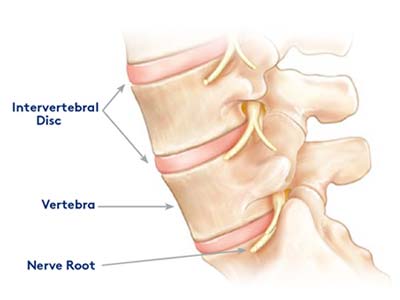Globus Excelsius™
The Healthy Spine
 The spine is one of the most important structures in the human body. It supports much of the body's weight and protects the spinal cord, which
carries information from the brain to the rest of the body. The spine is strong but flexible, allowing for a wide range of movements.
The spine is one of the most important structures in the human body. It supports much of the body's weight and protects the spinal cord, which
carries information from the brain to the rest of the body. The spine is strong but flexible, allowing for a wide range of movements.
The spine is made up of vertebrae and is divided into three main sections:
- Cervical (7 vertebrae)
- Thoracic (12 vertebrae)
- Lumbar (5 vertebrae)
Below the lumbar spine is the sacrum, which is comprised of five fused vertebrae. At the end of the spine is the coccyx or the tailbone.
Individual vertebrae are separated by intervertebral discs, which act as cushions or shock absorbers between the vertebral bodies.

What is Minimally Invasive Spine Surgery?
Minimally invasive surgery combines your surgeon’s understanding of anatomy with x-ray imaging to treat spine conditions using small incisions. A minimally invasive technique permits the surgeon to separate the muscles surrounding the spine rather
than cut through them. The surgeon operates through small incisions along the spine.
Potential benefits of minimally invasive surgery can include shorter hospital stays, less tissue damage and smaller incisions, which may lead to smaller scars.
It is important to understand that the decision to receive minimally invasive surgery is individualized to the patient and the patient's symptoms. It is important to discuss with your physician whether minimally invasive surgery is right for you.
How Does ExcelsiusGPS™ Work?
 ExcelsiusGPS™ is designed to improve accuracy and optimize patient care by using robotics and navigation, much like a GPS in your car.
ExcelsiusGPS™ is designed to improve accuracy and optimize patient care by using robotics and navigation, much like a GPS in your car.
On the day of surgery medical images are taken and imported into ExcelsiusGPS™. The surgeon uses these images to determine the size and placement of implants and creates a patient plan based on your anatomy. This is used to guide the rigid robotic
arm to a specific region of your spine, similar to a planned route or pathway on a GPS. The surgeon uses this pathway or route to accurately place the implants using instruments.
Throughout the procedure, the surgical instruments and implants are continuously displayed on the screen for the surgeon and staff to monitor. This display allows the surgeon to view live feedback during your procedure for more precise implant placement.
Questions to Ask Your Surgeon
If you are experiencing chronic back pain that is unresponsive to non-surgical treatment, you may be a candidate for minimally invasive spine surgery in conjunction with ExcelsiusGPS™. Talk to your doctor to learn more and find out if this option
is right for you.
- Am I a candidate for minimally invasive spine surgery with ExcelsiusGPS™?
- How can I benefit from minimally invasive spine surgery with ExcelsiusGPS™?
- What can I expect the day of the surgery?
- What can I expect post surgery?
